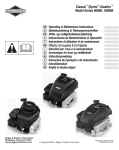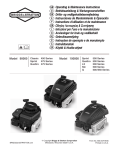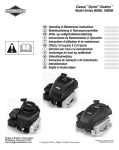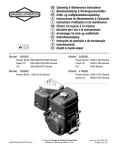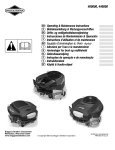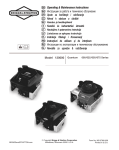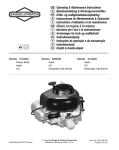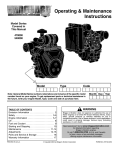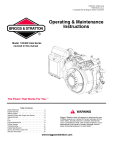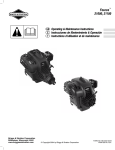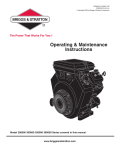Download Briggs & Stratton 190000 Technical information
Transcript
190000, 280000
GB
D
DK
E
F
GR
I
N
NL
P
S
SF
Briggs & Stratton Corporation
Milwaukee, Wisconsin 53201
www.briggsandstratton.com
Operating & Maintenance Instructions
Betriebsanleitung & Wartungsvorschriften
Drifts− og vedligeholdelsesvejledning
Instrucciones de Mantenimiento & Operación
Instructions d’utilisation et de maintenance
Ïäçãßåò Ëåéôïõñãßáò & ÓõíôÞñçóçò
Istruzioni per l’uso e la manutenzione
Anvisninger for bruk og vedlikehold
Gebruiksaanwijzing
Instruções de operação e de manutenção
Instruktionsbok
Käyttö & Huolto−ohjeet
Copyright 2003 by Briggs & Stratton Corporation
FORM NO. MS-6331-5/03
PRINTED IN U.S.A.
8
7
6
9
5
4
3
2
10
1
Ë
Ê
Ì
11
12
13
14
15
Ê
**
*
°F
°C
-20
-30
Ê
20
0
-20
32
-10
40
0
60
10
80
20
100
30
40
Ë
Ë
Ì
Ê
Ì
Document: - page 1 (Black)
Screen angle and frequency: 45.0000, 150.0000
GB
Note: (This note applies only to engines used in the U.S.A.) Maintenance, replacement or repair of the emission control devices and systems may be performed
by any nonroad engine repair establishment or individual. However, to obtain no charge repairs under the terms and provisions of the Briggs & Stratton
warranty statement, any service or emission control part repair or replacement must be performed by a factory authorized dealer.
Engine Components (see fig. )
How To Use Manual Figures
−
1
− 19
−
1 Engine
refer to figures inside covers.
refer to engine components in figure
.
refer to part/action in figures.
Record your engine Model, Type and Code numbers
here for future use.
Record your date of purchase here for future use.
In the state of California, OHV Model Series 400000 and
460000 engines are certified by the California Air
Resources Board to meet emissions standards for 250
hours. Such certification does not grant the purchaser,
owner or operator of this engine any additional
warranties with respect to the performance or opera−
tional life of this engine. This engine is warranted solely
according to the product and emissions warranties
stated elsewhere in this manual.
2
3
4
5
6
7
8
9
10
11
12
13
14
15
Model
Type
Code
xxxxxx xxxx xx xxxxxxxx
12V electric starter, if equipped
Drain plug
Fuel tank
Fuel fill
Oil fill/Dipstick
Finger guard
Rope handle
Air cleaner
Spark plug
Rotating screen
Blower housing
Fuel filter, if equipped
Carburetor
Muffler/Spark arrester, if equipped
Hazard Symbols and Meanings
Technical Information
POWER RATINGS: The power ratings for an individual
engine model are initially developed by starting with
SAE (Society of Automotive Engineers) code J1940
(Small Engine Power & Torque Rating Procedure) (Re−
vision 2002−05). Given both the wide array of products
on which our engines are placed, and the variety of en−
vironmental issues applicable to operating the equip−
ment, it may be that the engine you have purchased will
not develop the rated horsepower when used in a piece
of power equipment (actual on−site" power). This dif−
ference is due to a variety of factors including, but not
limited to, the following: differences in altitude, temper−
ature, barometric pressure, humidity, fuel, engine lu−
brication, maximum governed engine speed, individual
engine to engine variability, design of the particular
piece of power equipment, the manner in which the en−
gine is operated, engine run−in to reduce friction and
clean out of combustion chambers, adjustments to the
valves and carburetor, and other factors. The power
ratings may also be adjusted based on comparisons to
other similar engines utilized in similar applications,
and will therefore not necessarily match the values de−
rived using the foregoing codes.
GB
Safety Precautions
BEFORE OPERATING ENGINE
• Read entire Operating & Maintenance Instructions
AND the instructions for the equipment this engine
powers.*
• Failure to follow instructions could result in serious
injury or death.
* Briggs & Stratton does not necessarily know what
equipment this engine will power. For that reason,
you should carefully read and understand the
operating instructions for the equipment on which
your engine is placed.
THE OPERATING & MAINTENANCE
INSTRUCTIONS CONTAIN SAFETY
INFORMATION TO
• Make you aware of hazards associated with engines
• Inform you of the risk of injury associated with those
hazards, and
• Tell you how to avoid or reduce the risk of injury.
The safety alert symbol is used to identify safety
information about hazards that can result in personal injury.
Fire
Explosion
Toxic Fumes
Kickback
Moving Parts
Hot Surface
Shock
A signal word (DANGER, WARNING, or CAUTION) is used
with the alert symbol to indicate the likelihood and the potential
severity of injury. In addition, a hazard symbol may be used to
represent the type of hazard.
DANGER indicates a hazard which, if not avoided,
will result in death or serious injury.
WARNING indicates a hazard which, if not avoided,
could result in death or serious injury.
International Symbols and Meanings
Safety Alert
On Off
Stop
Choke
CAUTION indicates a hazard which, if not avoided,
might result in minor or moderate injury.
CAUTION, when used without the alert symbol,
indicates a situation that could result in damage to
the engine.
WARNING
Read Owner’s
Manual
Oil
Fuel
1
Fuel Shutoff
The engine exhaust from this product contains
chemicals known to the State of California to cause
cancer, birth defects, or other reproductive harm.
GB
WARNING
WARNING
WARNING
Gasoline and its vapors are extremely flammable
and explosive.
Engines give off carbon monoxide, an odorless,
colorless, poison gas.
Running engines produce heat. Engine parts,
especially muffler, become extremely hot.
Fire or explosion can cause severe burns or death.
Breathing carbon monoxide can cause nausea,
fainting or death.
Severe thermal burns can occur on contact.
WHEN ADDING FUEL
• Turn engine OFF and let engine cool at least 2
minutes before removing gas cap.
• Fill fuel tank outdoors or in well−ventilated area.
• Do not overfill fuel tank. Fill tank to approximately
1−1/2 inches below top of neck to allow for fuel
• Start and run engine outdoors.
• Do not start or run engine in enclosed area, even if
doors or windows are open.
expansion.
• Keep gasoline away from sparks, open flames, pilot
lights, heat, and other ignition sources.
• Check fuel lines, tank, cap, and fittings frequently
for cracks or leaks. Replace if necessary.
WARNING
WHEN STARTING ENGINE
• Make sure spark plug, muffler, fuel cap and air
cleaner are in place.
• Do not crank engine with spark plug removed.
• If fuel spills, wait until it evaporates before starting
engine.
• If engine floods, set choke to OPEN/RUN position,
place throttle in FAST and crank until engine starts.
WHEN OPERATING EQUIPMENT
• Do not tip engine or equipment at angle which
causes gasoline to spill.
• Do not choke carburetor to stop engine.
WHEN TRANSPORTING EQUIPMENT
• Transport with fuel tank EMPTY or with fuel shut−off
valve OFF.
WHEN STORING GASOLINE OR EQUIPMENT WITH
FUEL IN TANK
Combustible debris, such as leaves, grass, brush,
etc. can catch fire.
• Allow muffler, engine cylinder and fins to cool before
touching.
• Remove accumulated combustibles from muffler
area and cylinder area.
• Install and maintain in working order a spark
arrester before using equipment on forest−covered,
grass−covered, brush−covered unimproved land.
The state of California requires this (Section 4442 of
the California Public Resources Code). Other
states may have similar laws. Federal laws apply on
federal land.
Unintentional sparking can result in fire or electric
shock.
Unintentional start−up can result in entanglement,
traumatic amputation, or laceration.
WARNING
BEFORE PERFORMING ADJUSTMENTS OR RE−
PAIRS
• Disconnect spark plug wire and keep it away from
spark plug.
• Disconnect battery at negative terminal (only
engines with electric start).
WHEN TESTING FOR SPARK
• Use approved spark plug tester.
• Do not check for spark with spark plug removed.
• Store away from furnaces, stoves, water heaters or
other appliances that have pilot light or other ignition
source because they can ignite gasoline vapors.
Rotating parts can contact or entangle hands, feet,
hair, clothing, or accessories.
Traumatic amputation or severe laceration can
result.
•
•
•
•
Operate equipment with guards in place.
Keep hands and feet away from rotating parts.
Tie up long hair and remove jewelry.
Do not wear loose−fitting clothing, dangling
drawstrings or items that could become caught.
WARNING
WARNING
Starting engine creates sparking.
Rapid retraction of starter cord (kickback) will pull hand
and arm toward engine faster than you can let go.
Sparking can ignite nearby flammable gases.
Broken bones, fractures, bruises or sprains could
result.
Explosion and fire could result.
• If there is natural or LP gas leakage in area, do not
start engine.
• Do not use pressurized starting fluids because
vapors are flammable.
• When starting engine, pull cord slowly until
resistance is felt, then pull rapidly.
• Remove all external equipment/engine loads
before starting engine.
• Direct coupled equipment components such as, but
not limited to, blades, impellors, pulleys, sprockets,
etc., must be securely attached.
2
GB
Oil Recommendations (see fig. )
Engine shipped from Briggs & Stratton without oil.
Before starting engine, fill with oil. Do not over−fill.
Use a high quality detergent oil classified For Service
SF, SG, SH, SJ" or higher such as Briggs & Stratton
30W, Part Number 100005 (20 oz.) or 100028 (48 oz.).
Use no special additives with recommended oils. Do
not mix oil with gasoline.
Choose the SAE viscosity grade of oil from this chart
that matches the starting temperature anticipated
before the next oil change. (see fig. )
Note: Synthetic oil meeting ILSAC
GF−2, API certification mark and API ser−
vice symbol (shown at left) with SJ/CF
ENERGY CONSERVING" or higher, is an
acceptable oil at all temperatures. Use of
synthetic oil does not alter required oil
change intervals.
*
Air cooled engines run hotter than automotive
engines. The use of non−synthetic multi−viscosity
oils (5W−30, 10W−30, etc.)in temperatures above
40° F (4° C) will result in higher than normal oil
consumption. When using a multi−viscosity oil,
check oil level more frequently.
** SAE 30 oil, if used below 40° F (4° C), will result
in hard starting and possible engine bore
damage due to inadequate lubrication.
Check oil level (see fig. )
Oil capacity of Model Series 190000 is about 1.1 liters
(36 ounces). Oil capacity of Model Series 280000 is
about 1.4 liters (48 ounces).
Place engine level and clean around oil fill .
Remove dipstick , wipe with clean cloth, insert and
tighten down again. Remove dipstick and check oil
level. Oil should be at FULL mark .
If oil is required, add slowly. Tighten dipstick firmly
before starting engine.
Fuel Recommendations
Use clean, fresh, lead−free gasoline with a minimum of
77 octane. Leaded gasoline may be used if it is
commercially available and if unleaded is unavailable.
Purchase fuel in quantity that can be used within 30
days. See Storage.
In U.S.A. leaded gasoline may not be used. Some
fuels, called oxygenated or reformulated gasolines, are
gasolines blended with alcohols or ethers. Excessive
amounts of these blends can damage the fuel system
or cause performance problems. If any undesirable
operating symptoms occur, use gasoline with a lower
percentage of alcohol or ether.
This engine is certified to operate on gasoline. Exhaust
Emission Control System: EM (Engine Modifications).
Do not use gasoline which contains Methanol. Do not
mix oil with gasoline.
For engine protection, we recommend using Briggs &
Stratton Fuel Stabilizer available from an Authorized
Briggs & Stratton Service Dealer.
Check fuel level.
Starting (see figs. )
ALWAYS KEEP HANDS AND FEET
CLEAR OF EQUIPMENT MOVING PARTS.
Do not use a pressurized starting
fluid. Vapors are flammable.
Start, store and fuel lawn mower in level position. Start
lawn mower on hard surface or over previously cut grass.
Check oil level.
Open fuel shut−off valve 1/4 turn counterclockwise, if
equipped.
Before starting engine (see fig. )
1. Move equipment control to CHOKE or START
position .
Note: If engine does not start, remove air cleaner to check
choke. Choke must fully close. If not, see Adjustments.
2. If equipment has separate choke and throttle
controls, move throttle control to FAST position .
3. Open fuel shut−off valve 1/4 turn, if equipped.
Rewind starter (see fig.
)
Grasp rope handle and pull slowly until
resistance is felt. Then pull cord rapid−
ly to overcome compression, prevent
kickback and start engine. Repeat if necessary with
throttle in FAST. When engine starts, operate in FAST.
Electric starter (see fig. )
On engines equipped with 12 volt starting systems, turn
key to START position . Repeat if necessary with
throttle control in FAST position. When engine starts,
operate in FAST position.
Note: If equipment manufacturer has supplied battery,
charge it before trying to start engine, as equipment
manufacturer recommends.
Note: Use short starting cycles (15 secs. per min.) to
prolong starter life. Extended cranking can damage
starter motor.
Stopping (see fig. )
Do not move choke control to CHOKE to stop engine.
Backfire or engine damage may occur. Move throttle
control to IDLE or SLOW position, then to STOP or
turn key to OFF , if equipped.
Always remove key from switch when equipment is not
in use or left unattended.
When engine or equipment is transported, close fuel
shut−off valve 1/4 turn, if equipped, to prevent fuel
leakage.
Adjustments (see fig. )
To prevent acci−
dental starting, re−
move spark plug
wire and ground
it before adjusting, and disconnect battery at negative
terminal, if equipped.
Choke control adjustments
Move choke control to CHOKE or START position.
Remove air cleaner to check that choke valve is closed.
To assure choke valve is closed, loosen casing clamp
screw and pull casing and wire in direction of
arrow to end of travel. Tighten casing clamp screw.
Throttle control adjustments
With throttle control in FAST position, hole in governor
control lever (located just behind governor control
plate ) must align with hole in governor control
plate. If they do not align, loosen casing clamp screw and then move governor control rack until they do.
Tighten casing clamp screw.
Check stop switch
Move throttle control to STOP position, if equipped.
Governor control lever must make good contact with
stop switch .
Check operation of controls. Readjust if necessary.
Carburetor adjustments
The manufacturer of the equipment on which
this engine is installed specifies top speed at
which the engine will be operated. DO NOT
EXCEED this speed.
See an Authorized Briggs & Stratton Dealer for
carburetor adjustment.
The carburetor on this engine is low emission. It is
equipped with an idle mixture valve with a limiter (see
inset), which allows some adjustment, and an idle
speed adjustment screw.
Start engine and warm up approximately 5 minutes
before adjusting. With engine running, place throttle
control in SLOW position. Rotate carburetor throttle
lever against the idle speed screw and hold it. Turn idle
speed screw to obtain 1750 rpm.
Rotate idle mixture valve full travel clockwise and then
counterclockwise. DO NOT remove limiter cap. DO
NOT force beyond limit. Finally, position idle mixture
valve in middle of travel. Check idle speed and
re−adjust to 1750 rpm, if necessary.
Move throttle control to FAST position. Engine should
accelerate smoothly. If it does not, adjust idle mixture
valve counterclockwise 1/8 turn.
CARBURETOR
THROTTLE
LEVER
IDLE
SPEED
SCREW
Before refueling, allow
engine to cool 2 minutes.
Clean around fuel fill before removing cap to refuel. Fill
tank to approximately 1−1/2 inches below top of neck to
allow for fuel expansion. Be careful not to overfill.
3
IDLE
MIXTURE
VALVE
WITH
LIMITER
GB
Maintenance (see figs. )
Also, see Maintenance Schedule. Follow the hourly or
calendar intervals, whichever occur first. More frequent
service is required when operating in adverse conditions.
See any Authorized Briggs & Stratton Dealer for correct
replacement parts
To prevent acci−
dental starting, re−
move spark plug
wire and ground
it before servicing,
and disconnect battery at negative terminal, if equipped.
Oil service (see fig. )
Check oil level regularly.
Be sure correct oil level is maintained. Check every 5
hours or daily, before starting engine. See oil filling
procedure, Oil Recommendations.
Change oil.
Change oil after first 5 hours of operation. Change oil
while engine is warm. Refill with new oil of recom−
mended SAE viscosity grade. (see fig. )
Air cleaner service
Replace oil foam element or pre−cleaner, if equipped,
or cartridge if very dirty or damaged.
Air cleaner, dual element (see fig. )
1. Remove knob and cover .
2. Carefully remove knob, cartridge and
pre−cleaner , if equipped, to prevent debris
from falling into carburetor.
3. Carefully clean base .
To service pre−cleaner, wash in liquid detergent and
water. Squeeze dry in a clean cloth. Saturate in engine
oil. Squeeze in clean, absorbent cloth to remove
excess oil.
To service cartridge, clean by tapping gently on a flat
surface. Do not use petroleum solvents, e.g.,
kerosene, which will cause cartridge to deteriorate. Do
not use pressurized air, which can damage cartridge.
Do not oil cartridge.
4. Reassemble pre−cleaner on cartridge and install
assembly firmly in base and tighten knob securely.
5. Replace cover and tighten knob securely.
Maintenance Cont’d
Spark plug service (see fig.
)
DO NOT check for spark
with spark plug removed.
Use only Briggs & Stratton
Spark Tester , to check
for spark.
DO NOT crank engine with spark plug removed. If
engine is flooded, place throttle in FAST and crank until
engine starts.
Spark plug gap should be .76 mm or 0.030 in.
Replace spark plug every 100 hours or every season,
whichever occurs first. Spark tester and spark plug
wrench are available from any Authorized Briggs &
Stratton Service Dealer.
Note: In some areas, local law requires using a resistor
spark plug to suppress ignition signals. If this engine
was originally equipped with resistor spark plug, use
same type of spark plug for replacement.
Keep engine clean (see fig. )
Periodically remove grass and chaff build−up from
engine. Clean finger guard. Do not spray engine with
water to clean because water could contaminate fuel.
Clean with a brush or compressed air.
Accumulation of debris around muf−
fler could cause a fire. Inspect and
clean before every use.
If muffler is equipped with spark arrester screen ,
remove spark arrester screen for cleaning and inspection
every 50 hours or every season. Replace if damaged.
Replace in−line fuel filter. Drain fuel tank
or close fuel shut−off valve before
replacing filter (see fig. ).
Clean cooling system. Grass or chaff may clog engine’s
air cooling system, especially after prolonged service
cutting tall, dry grass. Internal cooling fins and surfaces
may require cleaning to prevent overheating and
engine damage. Remove blower housing to clean
areas within heavy line .
4
Maintenance Schedule
Follow the hourly or calendar intervals, whichever
occur first. More frequent service is required when
operating in adverse conditions noted below.
First 5 Hours
D Change oil
Every 5 hours or daily
D Check oil level
D Clean finger guard and around muffler
Every 25 hours or every season
D Change oil if operating under heavy load or
high ambient temperature
D Service air cleaner Oil Foam element or
pre−cleaner, if equipped*
D Service air cleaner cartridge if no pre−cleaner*
Every 50 hours or every season
D Change oil
D Clean and inspect spark arrester, if equipped.
Every 100 hours or every season
D Service air cleaner cartridge if equipped with
pre−cleaner*
D Replace in−line fuel filter, if equipped.
D Clean cooling system*
D Clean or replace spark plug
* Clean more often under dusty conditions, or
when airborne debris is present or after
prolonged operation cutting tall, dry grass.
Partial List of Genuine Briggs & Stratton Parts
Briggs & Stratton (or equivalent)
Part
Part No.
Oil (20 oz.) . . . . . . . . . . . . . . . . . . . . . . . . 100005
Oil (48 oz.) . . . . . . . . . . . . . . . . . . . . . . . . 100028
Oil pump kit (uses standard electric drill . . . . . 5056
to remove oil from engine quickly)
Fuel stabilizer (1 oz., 30 ml single use pouch) 992030
Fuel stabilizer (4.2 oz., 125 ml bottle)999005E (5041)
Fuel filter (without fuel pump) . . . . . . 298090 (5018)
Fuel filter (with fuel pump) . . . . . . . . . . . . . 394358
Air cleaner cartridge (6 cm high) . . . . . . . . . 493910
Air cleaner pre−cleaner (6 cm high) . . . . . . . 272477
Air cleaner cartridge (7.5 cm high) . . . . . . . 496894
Air cleaner pre−cleaner (7.5 cm high) . . . . . . 272403
Resistor spark plug . . . . . . . . . . . . . . . . . 802592E
Standard spark plug . . . . . . . . . . . . . . . . 492167E
Long life platinum spark plug . . . . . . 992041 (5062)
(used on most L−head engines)
Spark tester . . . . . . . . . . . . . . . . . . . . . . . . 19368
Spark plug wrench . . . . . . . . . . . . . 89838 (5023)
Spark arrester . . . . . . . . . . . . . . 399541 or 392390
GB
Storage
Service
Engines stored over 30 days need to be protected or
drained of fuel to prevent gum from forming in fuel
system or on essential carburetor parts.
For engine protection, we recommend use of Briggs &
Stratton Fuel Stabilizer available from an Authorized
Briggs & Stratton Service Dealer. Mix stabilizer with fuel
in fuel tank or storage container. Run engine for a short
time to circulate stabilizer through carburetor. Engine
and fuel can be stored up to 24 months.
Note: If stabilizer is not used or if engine is operating on
gasoline containing alcohol, e.g. gasohol, remove all fuel
from tank and run engine until it stops from lack of fuel.
1. Change oil. See Oil service. (see figs. )
2. Remove spark plug and pour about 30 ml (1 oz) of
engine oil into cylinder. Replace spark plug and
crank slowly to distribute oil.
3. Clean grass and chaff from cylinder and cylinder
head fins, under finger guard and behind muffler.
4. Store in a clean and dry area, but NOT near a
stove, furnace or water heater which uses a pilot
light or any device that can create a spark.
See an Authorized Briggs & Stratton Service Dealer.
Each one carries a stock of Genuine Briggs & Stratton
Parts and is equipped with special service tools.
Trained mechanics assure expert repair service on all
Briggs & Stratton engines. Only dealers advertising as
Authorized Briggs & Stratton" are required to meet
Briggs & Stratton standards.
When you purchase equipment pow−
ered by a Briggs & Stratton engine, you
are assured of highly skilled, reliable
service at more than 30,000 Authorized
Service Dealers worldwide, including
more than 5,000 Master Service Techni−
cians. Look for these signs wherever
Briggs & Stratton service is offered.
You may locate your nearest Authorized Briggs & Stratton
Service Dealer in our dealer locator map on our web site
www.briggsandstratton.com or in the Yellow
Pages" directory under Engines, Gasoline"
or Gasoline Engines," or Lawn Mowers" or
similar category.
Note: Walking fingers logo and Yellow Pages" are
registered trademarks in various jurisdictions.
An illustrated shop manual includes Theories of
Operation," common specifications and detailed
information covering adjustment, tune−up and repair of
Briggs & Stratton L−head, single cylinder, 4 cycle
engines. Order P/N 270962 from an Authorized Briggs
& Stratton Service Dealer.
Insist on Genuine Briggs & Stratton replacement parts
with our logo on the box and/or part. Non−original parts
may not perform as well and may void your warranty.
5
GB
BRIGGS & STRATTON ENGINE OWNER WARRANTY POLICY
Effective January 1, 2003 replaces all undated Warranties and all Warranties dated before January 1, 2003
LIMITED WARRANTY
Briggs & Stratton Corporation will repair or replace, free of charge, any part(s) of the engine that is defective in material or workmanship or both. Transportation charges on parts submitted for repair or replacement under this warranty must be borne by purchaser. This warranty is effective for the time
periods and subject to the conditions stated below. For warranty service, find the nearest Authorized Service Dealer in our dealer locator map at
www.briggsandstratton.com, or by calling 1-800-233-3723, or as listed in the ‘Yellow Pages’.
THERE IS NO OTHER EXPRESS WARRANTY. IMPLIED WARRANTIES, INCLUDING THOSE OF MERCHANTABILITY AND FITNESS FOR A PARTICULAR PURPOSE, ARE LIMITED TO ONE YEAR FROM PURCHASE, OR TO THE EXTENT PERMITTED BY LAW ANY AND ALL IMPLIED WARRANTIES ARE EXCLUDED. LIABILITY FOR INCIDENTAL OR CONSEQUENTIAL DAMAGES ARE EXCLUDED TO THE EXTENT EXCLUSION IS
PERMITTED BY LAW. Some states or countries do not allow limitations on how long an implied warranty lasts, and some states or countries do not
allow the exclusion or limitation of incidental or consequential damages, so the above limitation and exclusion may not apply to you. This warranty gives
you specific legal rights and you may also have other rights which vary from state to state and country to country.
OUR PRODUCT
VANGUARD
Classic
ELS
I/Cr
Industrial Plus
Intek
(Sleeve Bore)
Fource
Intek
(Kool Bore)
Power Built OHV
QUANTUMr
Quattro
Q45
Sprint
2 years
2 years
1 year
1 year
90 days
90 days
Etek
WARRANTY PERIOD*
Consumer Use
Commercial Use
*
2 years
1 year
Note the following special warranty periods: 2 years for Classic engines in the European Union and Eastern European countries, for all consumer products in the European Union, and
for emission control systems on engines certified by EPA and CARB. 5 years for consumer use, 90 days for commercial use of Touch-N-Mow starter on Quantum and Intek engines.
Engines used in competitive racing or on commercial or rental tracks are not warrantied.
The warranty period begins on the date of purchase by the first retail consumer or commercial end user, and continues for the period of time stated in the table above. “Consumer use”
means personal residential household use by a retail consumer. “Commercial use” means all other uses, including use for commercial, income producing or rental purposes. Once an
engine has experienced commercial use, it shall thereafter be considered as a commercial use engine for purposes of this warranty.
NO WARRANTY REGISTRATION IS NECESSARY TO OBTAIN WARRANTY ON BRIGGS & STRATTON PRODUCTS. SAVE YOUR PROOF OF PURCHASE RECEIPT. IF
YOU DO NOT PROVIDE PROOF OF THE INITIAL PURCHASE DATE AT THE TIME WARRANTY SERVICE IS REQUESTED, THE MANUFACTURING DATE OF THE
PRODUCT WILL BE USED TO DETERMINE THE WARRANTY PERIOD.
ABOUT YOUR ENGINE WARRANTY
Briggs & Stratton welcomes warranty repair and apologizes to
you for being inconvenienced. Any Authorized Service Dealer
may perform warranty repairs. Most warranty repairs are han−
dled routinely, but sometimes requests for warranty service
may not be appropriate. For example, warranty would not apply
if engine damage occurred because of misuse, lack of routine
maintenance, shipping, handling, warehousing or improper
installation. Similarly, warranty is void if the serial number of the
engine has been removed or the engine has been altered or
modified.
If a customer differs with the decision of the Service Dealer, an
investigation will be made to determine whether the warranty
applies. Ask the Service Dealer to submit all supporting facts to
his Distributor or the Factory for review. If the Distributor or the
Factory decides that the claim is justified, the customer will be
fully reimbursed for those items that are defective. To avoid mis−
understanding which might occur between the customer and
the Dealer, listed below are some of the causes of engine failure
that the warranty does not cover.
Normal wear:
Engines, like all mechanical devices, need periodic parts ser−
vice and replacement to perform well. Warranty will not cover
repair when normal use has exhausted the life of a part or an
engine.
Improper maintenance:
The life of an engine depends upon the conditions under which it
operates, and the care it receives. Some applications, such as
tillers, pumps and rotary mowers, are very often used in dusty or
dirty conditions, which can cause what appears to be premature
wear. Such wear, when caused by dirt, dust, spark plug cleaning
grit, or other abrasive material that has entered the engine be−
cause of improper maintenance, is not covered by warranty.
This warranty covers engine related defective material and/
or workmanship only, and not replacement or refund of the
equipment to which the engine may be mounted. Nor does
the warranty extend to repairs required because of:
1. PROBLEMS CAUSED BY PARTS THAT ARE NOT
ORIGINAL BRIGGS & STRATTON PARTS.
2. Equipment controls or installations that prevent starting,
cause unsatisfactory engine performance, or shorten en−
gine life. (Contact equipment manufacturer.)
3. Leaking carburetors, clogged fuel pipes, sticking valves,
or other damage, caused by using contaminated or stale
fuel. (Use clean, fresh, lead−free gasoline and Briggs &
Stratton Fuel Stabilizer, Part No. 5041.)
4. Parts which are scored or broken because an engine was
operated with insufficient or contaminated lubricating oil,
or an incorrect grade of lubricating oil (check oil level daily
or after every 8 hours of operation. Refill when necessary
and change at recommended intervals.) OIL GARD
may not shut down running engine. Engine damage may
occur if oil level is not properly maintained. Read Operat−
ing & Maintenance Instructions.
5. Repair or adjustment of associated parts or assemblies
such as clutches, transmissions, remote controls, etc.,
which are not manufactured by Briggs & Stratton.
6. Damage or wear to parts caused by dirt, which entered
the engine because of improper air cleaner maintenance,
re−assembly, or use of a non−original air cleaner element
or cartridge. (At recommended intervals, clean and re−oil
Briggs & Stratton Engines Are Made Under One Or More Of The Following Patents: Design D−247,177 (Other Patents Pending)
5,235,943
5,497,679
5,606,948
5,819,513
6,077,063
6,325,036
5,197,425
5,320,795
5,606,851
5,813,384
6,064,027
6,284,123
5,197,422
5,271,363
5,548,955
5,765,713
6,014,808
6,260,529
5,191,864
5,269,713
5,546,901
5,645,025
5,894,715
6,230,678
5,188,069
5,265,700
5,503,125
5,642,701
5,852,951
6,202,616
5,823,153
6,116,212
5,186,142
5,243,878
5,501,203
5,619,845
6
5,138,996
5,086,890
5,070,829
5,058,544
5,040,644
5,009,208
the Oil−Foam element or the foam pre−cleaner, and
replace the cartridge.) Read Operating & Maintenance
Instructions.
7. Parts damaged by over−speeding, or overheating caused
by grass, debris, or dirt, which plugs or clogs the cooling
fins, or flywheel area, or damage caused by operating the
engine in a confined area without sufficient ventilation.
(Clean fins on the cylinder, cylinder head and flywheel at
recommended intervals.) Read Operating & Maintenance
Instructions.
8. Engine or equipment parts broken by excessive vibration
caused by a loose engine mounting, loose cutter blades,
unbalanced blades or loose or unbalanced impellers, im−
proper attachment of equipment to engine crankshaft,
over−speeding or other abuse in operation.
9. A bent or broken crankshaft, caused by striking a solid ob−
ject with the cutter blade of a rotary lawn mower, or exces−
sive v−belt tightness.
10. Routine tune−up or adjustment of the engine.
11. Engine or engine component failure, i.e., combustion
chamber, valves, valve seats, valve guides, or burned
starter motor windings, caused by the use of alternate
fuels such as, liquified petroleum, natural gas, altered
gasolines, etc.
Warranty is available only through service dealers which
have been authorized by Briggs & Stratton Corporation.
your nearest Authorized Service Dealer is listed in the Yel−
low Pages" of your telephone directory under Engines,
Gasoline" or Gasoline Engines," Lawn Mowers," or simi−
lar category.
4,996,956
4,977,879
4,971,219
4,895,119
4,819,593
4,719,682
4,633,556
4,630,498
4,522,080
4,520,288
4,512,499
4,453,507
4,430,984
DES. 308,871
DES. 308,872
DES. 309,457
DES. 356,951
DES. 361,771
DES. 375,963
Ë
Í
Î
Ê
Ï
Ñ
Ì
Ð
Ò
Ë
Ë
Ì
Í
Î
Î
Ë
Ì
0.030”
(.76mm)
Document: - page 1 (Black)
Screen angle and frequency: 45.0000, 150.0000
Í
Ï
!! " #$% & " #'
! "# $$% &' # $(
)' & *++, ' )&- )) ' &- '
&' ' ! *++. ' # )) $)' ' '
) ) ' ' & /! *- 011* '
23 3 43 %3 %- $ %5 3 6
7
3
7 33 43 7
3 0111 3 7
22(3 23(
- 8 7
22(3 74 - 4
94 7 : 3 (
7 3 83 - 8 (3- 3;( 32 23
7
3 *++. 3- 74 7 7
3 3 23 $ %5 74 833
7 3
7 43 23 3 2 7 8- 3< 3 4- 3 733 7 2 43 7
22(3 !43 7 3
7 4 3 4 3433- 3 3- 77422
3 <33 4 7 3 3 7 3
(
7
3 833
6- %5 8
33 43 7
22(3 4
4 - 3 3
& " & " 7
22(3 3 833 3
< 7 3
3 2 23 3 2 8
3- 4= 3< 23 8 2 <3 3 43 2<- 3
8
33 3 3
%5
#$% " '
7
22(3 83- 4 3 3
23 3237 2 3943 7(
43 3 34 %5 377 4 3 43 3 <3 7 43 7
22(3 - 4 %5 833
23 ; 2 3 3 23 43 2
43 43 3237 2 4
7(
7
22(3 83- 4 4
8<3 83 %5 7 4 833
<3 2 43 7
22(3 3 3 2
4 4- - 733 7(
3 43< 72
!4 3 3
23 3 43 7
22(3 43> %5 3< '
3
3
7 6 44 833 33 4
7
3
74 2 7- 6 ?1 2 4 < 94 33 43 833 3 3
- 4 4
%5 3< 3< *(@*@(0,+(,0A0
7 833 2 833 '2 3 =4 37
3237
833 3
(4 7 & " 2
8 3 2 3< 3
< 43 7 3
'2 33 <3 %5 833 23 (34
24 3 34
0 2 <3
* 33 $3
%5 833 83 494 433 33 $3
<3 43 833 6 3 8 7 3
23 237 2 73
83;7 8 4 2
43 2 3(
7 3 6 3 83 3 43
3 $3 23 3 2 8 3 237 <3 3
433
? 3
&4
3 7
3 3 3
7 2 33 $3 8
3237 3 83- (
• 3 37 7 2 ;
4 3 8 37 33 $3 2<- 2
83; 3237 43> %5 3< '
3 &3 7 833
• 3433 3
3
3< 43 3 43> %5 3< '
3 B!
8 $C
• &4
$47
43 B- #
-C B#
-C B8 83-C 3 7
3 3
3 4 7
• 3 3
• ; 72
7
• 3; 4
• 7
7
• <33
• 64 72
• 3 = 7 3 4
<
<
4 7 < 7
• "447- 7343- - 7 < <
< 8
• 3 7
@ 7 <3 6
4
33 7 2
3 8 3< 2 %5 33
$
33 <3 6
4 23 2
43 2 33 $3 8 3 3(
%5 3 3 4 2 4- 3 733 7 23 %5
33 $
%5 <3 2
43 2 33 $3 4 4 2 (- (3
- 3 72 3
, 33 $3 8 4
23 3
7 3943 7 3 8
4
23 34
3 22 2 B33 3 3
3C 833 2 23 833 3 33 $3 8 4
23
3
7 3943 7 833 2 23 3 2
7 4 23 4
3
7 23 3 3
7 3 94<
3237 43
7 4 3237 2 7 3 33
83 3
23 3237 2 3943 7- 2 %5 3 34
A 94
<3
<3 343 6 2
43 2 7 4 2
43
2 33 $3 43 833
(
) *
&' +, +
# -
('
3 32 7 23 3 43 %3 % 3 0 7 3 74 237 33 7 '43
$3 3 6 %3 5 3
7; 237 <
473 43 7 8
32 237
&' 3 473 2 43 2 4
34 7 23 8 32 7 7
- 47 33 7 3 8 3
5 34 2
8 3 3 4D
.
/
32 7 7
23 *0, 43 2 4
34 7
+/
32 7 7
23 0,1 43 2 4
34 7
,/
32 7 7
23 ,11 43 2 4
34 7
&3 67
- 8
;( 8 783 4 01 0, 43 3 3 323- &' 2 8 3 84
94 *1 *0 3
+, 4
473 3 3
< <
2 7 23 2 27
83 +,- 3 237 3
237 7 0 1 2333 (
) *
# ('
23 /4
*- 0111 3 %3 5 3 8
32 7 <37
$3 $ $ 0 7 3 &3 $ 0 32 - 7 7
$3 3233 7 7
473 2 3 43 23 8 8 7 &3
7 39437 &3 00, 7- 3 E *0, 43- % E 0,1 43 E ,11 43 &3 2 00, 3 73- 3 E 0,1 43- % E ,11 43 E *111 43
7 2 3 *+1111 ?*+ 7 2 3 0F1111 @A, 4 ' !
Document: - page 1 (Black)
Screen angle and frequency: 45.0000, 150.0000










